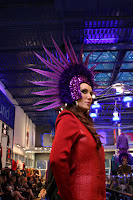"our impression of the world is based upon our total experience"
DAVID FOKOS

When you meet a person for the first time you often form an opinion of that person. But when you spend time with that person your perception changes, based upon your interaction with that person. I selected DAVID FOKOS because of his ability to transform potentially chaotic and turbulent texture and motion into serene and orderly calmness. What could have been chaotic has been transformed through time. What could have been grasses tossed about in the wind, or waves crashing against a shoreline, have been tamed by this man's ability to manipulate his camera. Fokos does this sucessfully by using long exposure times ranging from less than a minute to an hour in length. He filters out the "visual noise" of everyday life, using the camera "as a scientific instrument, the way a biologist might use a microscope or an astronomer a telescope, to reveal what is felt but often unseen." The resulting images make me want to walk softly through the scene, being careful not to disturb the serenity it holds.
David was born in Massachusetts in 1960 and currently lives in California. Over half of all his images have been captured near his childhood home in Martha's Vineyard. At first he began capturing color images, using a 35 mm Pentax camera. Fokos admits he struggled for 15 years, taking lousy pictures, until he was finally able to capture and express what he felt. In time he switched over to black and white photography, using an old, large-format view camera. Large-format view cameras typically use film format between 4x5", up to 20x24" single sheet film. As made evident by the work of David Fokos, large-format cameras produce sharper, better tone, grain-free images. He uses highlite elements, such as clouds or the moon suspended along the horizon, to create a strong balance in the image. It is a combination of these elements that make this photographer stand out for me. According to Fokos, via email, he creates his images using an 80-year-old 8x10 Korona View Camera, using a 210mm Rodenstock Sironar-S lens on Kodak Tri-X film developed in HC-110. Since he uses 8x10 film, grain is usually not an issue.
 I found "The Missing Rail" to be most appealing because the unknown, the unseen, are what cause me to feel apprehension and to question circumstance. The water and horizon are so calm, the light so flat and stark, like a calm after a storm. Is the missing railing all that remains after a tumble into the waters below? What happened? I don't know, but Fokos has me focused.
I found "The Missing Rail" to be most appealing because the unknown, the unseen, are what cause me to feel apprehension and to question circumstance. The water and horizon are so calm, the light so flat and stark, like a calm after a storm. Is the missing railing all that remains after a tumble into the waters below? What happened? I don't know, but Fokos has me focused.Technically this image was exposed for two minutes, and shot at either f/45 or f/64, Fokos did not specify this in his email.
 Moonrise, 2001, is characteristic of the photographer's style. Your eye is drawn through the image and up the pathway by the use of light. Strong texture suggests turbulent elements, yet they are suspended through the use of long exposures. The moon leads your eye upward, beyond the top-lite pathway, beyond the focal point. According to the photographer's email reply, technically this image was exposed three seconds (any longer and the moon would not have been round). Fokos used a wider aperture than f/64, slightly blurring the foreground. To maintain DOF he underexposed the negative and increased the development time from 5 minutes to 30 minutes, then put it in a selenium toner bath to add abit more density. This increased the grain in the negative, seen in the sand and the water.
Moonrise, 2001, is characteristic of the photographer's style. Your eye is drawn through the image and up the pathway by the use of light. Strong texture suggests turbulent elements, yet they are suspended through the use of long exposures. The moon leads your eye upward, beyond the top-lite pathway, beyond the focal point. According to the photographer's email reply, technically this image was exposed three seconds (any longer and the moon would not have been round). Fokos used a wider aperture than f/64, slightly blurring the foreground. To maintain DOF he underexposed the negative and increased the development time from 5 minutes to 30 minutes, then put it in a selenium toner bath to add abit more density. This increased the grain in the negative, seen in the sand and the water. When I look at Black Gate, 2000, my feet want to travel alongside my eye, down the boardwalk, to the end of the the dock. Threatening clouds have been tamed, calming the waters, calming the soul. This is what David Fokos images do for me, calm my soul. Technically, Black Gate was shot at either f/45 of f/64, with an exposure of 90 seconds.
When I look at Black Gate, 2000, my feet want to travel alongside my eye, down the boardwalk, to the end of the the dock. Threatening clouds have been tamed, calming the waters, calming the soul. This is what David Fokos images do for me, calm my soul. Technically, Black Gate was shot at either f/45 of f/64, with an exposure of 90 seconds.














